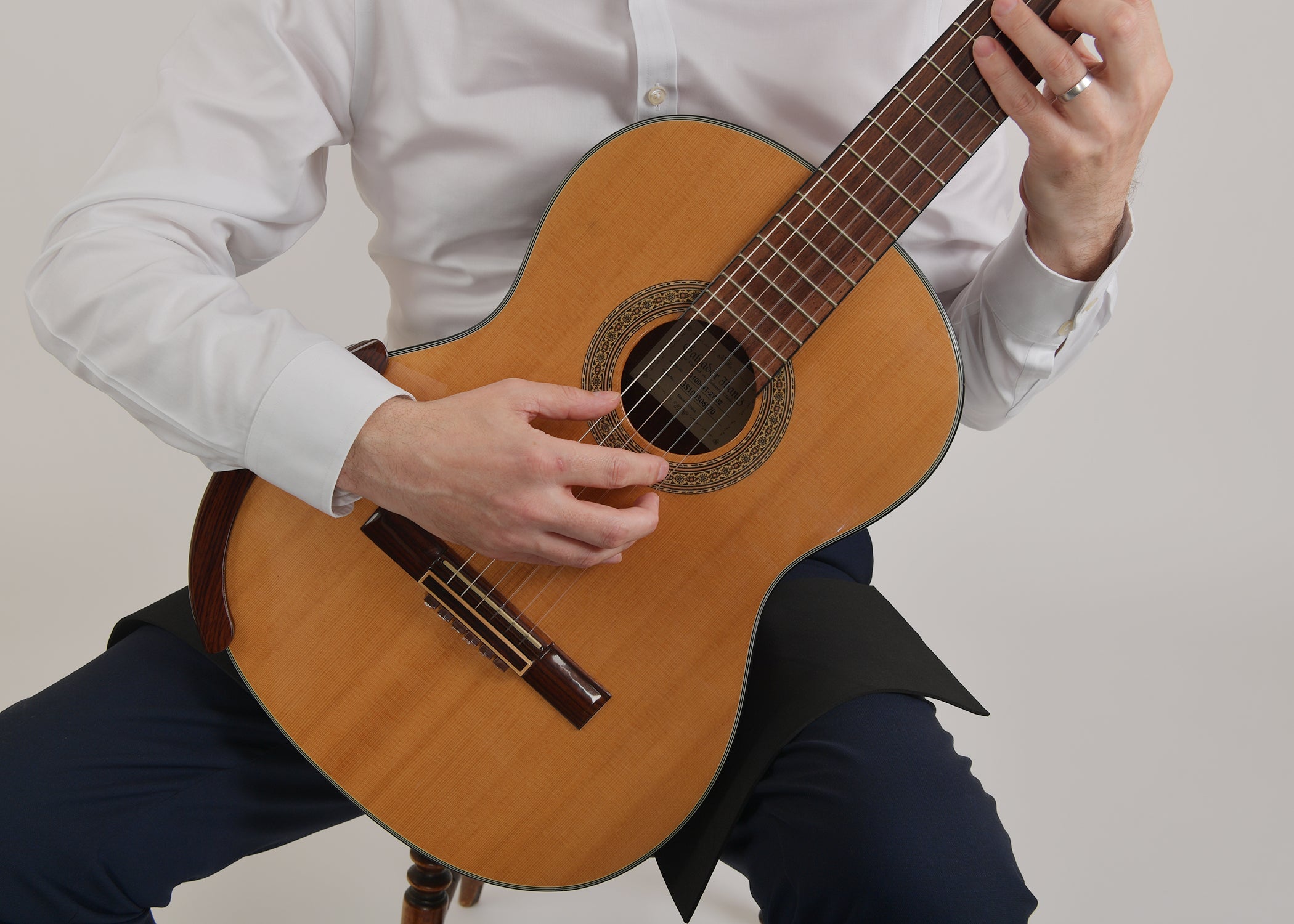Many classical guitarists, including experienced ones, sit in a way that works against them. The way you hold your classical guitar has a huge effect on how you play, how long you can practice, and how your body feels after a session.
Poor posture leads to tight shoulders, sore backs, and overworked wrists. It also gets in the way of clean playing and natural movement. Instead of enjoying the instrument, players often end up frustrated without knowing why.
A better position helps everything fall into place. Your hands move more freely, your fingers feel more relaxed, and your classical guitar sounds better with less effort. If you’re serious about improving your classical guitar playing, the way you sit is one of the first things to get right.
In this article, we’ll walk through simple ways to sit more comfortably and play more easily. You’ll also see how a classical guitar footstool or a guitar support can make a big difference. These small changes help you play longer, with more control and less pain.
Read Also: Double Top vs. Traditional Top Classical Guitars: Construction and Tone
Why Classical Guitar Posture Matters
The small things matter when you’re learning to play classical guitar. Posture might seem basic, but it shapes everything from your sound to how long you can play without discomfort.
Many players rush into technique without first learning how to sit properly, but starting with the right posture gives you the base you need to grow as a classical guitarist.
Finger work is only one part of the picture. How you position your shoulders, back, arms, and feet matters just as much.
A solid, relaxed posture helps your hands move freely across the strings. When your body feels cramped or tight, your playing often sounds the same, tense and disconnected.
Read Also: Classical Guitar Armrest: Comfort, Protection, and Superior Sound
If the correct position feels strange at first, that’s normal. But your back, legs, and arms will thank you later. A good posture helps you avoid aches and keeps your focus on the music. It also lets your classical guitar speak with a fuller voice.
A balanced position allows you to breathe with the rhythm and connect more naturally to the music you’re playing.
How Does a Classical Guitarist (Should) Sit with the Guitar?
While the setup might look slightly different from player to player, the goal is always the same: to hold the classical guitar in a stable and relaxed way that supports the music.
A well-balanced position involves four contact points between the guitar and the body:
1. The right forearm gently supports the top of the instrument
2. The side of the guitar touches the right thigh
3. The lower bout rests on the left thigh
4. The upper bout leans lightly into the chest.
This creates a natural sense of balance and keeps the guitar steady while you play. Ideally, the headstock of the classical guitar should be around eye level. This angle helps the fretting hand move freely across the neck while keeping the spine straight and relaxed.
Some classical guitarists use a footstool, others use a support device—what matters is that the guitar stays in place without needing to grip it too tightly.
Read Also: How Plastic Guitar Beads Improve Classical Guitar’s Sound
Guitar Position with a Footstool
Good posture is key when sitting with a classical guitar footstool. First, think about the size of your guitar. If you're playing a smaller instrument like a Torres or romantic guitar, it won’t sit the same way as a modern full-size 4/4 classical guitar. You might need to raise the footstool higher or switch to a classical guitar support (Alba GB Classical Guitar Supports), depending on the body shape and neck length.
When using a footstool, a few things matter more than most. Always check the position of the headstock; it should be around eye level. The guitar’s neck should point up at about a 45-degree angle or more.
Read Also: Plastic Guitar Beads vs Metal Guitar Beads
The body of the guitar should touch you at four contact points: left thigh, right thigh, chest, and right forearm. These keep the instrument steady while letting your hands move freely across the classical guitar strings.
The chair you sit on also plays a role. It should be high enough that your thighs remain level or slope slightly down. If the knees are too high, posture suffers, and playing gets uncomfortable fast.
Here are a few simple reminders for sitting with a classical guitar footstool:
• Keep your head, neck, and spine in line, don’t slouch or lean to one side
• Move slightly forward with your upper body when you play
• Raise your left foot using the footstool; keep your right foot flat on the ground
• Make sure your shoulders stay even and relaxed—check regularly for tension
• Keep the headstock near eye level for easier reach and more natural hand movement
Footstools come in different heights and adjustment levels. Some have four or five stages, but the Alba GB Footstool comes with six. It gives more flexibility, whether you're a teacher, student, or concert player. It’s a favorite among classical guitarists for its solid feel and good price.
Read Also: The Evolution of Classical Guitar Supports: Steadiness, Innovation
Posture with Guitar Support
You can also achieve a balanced and relaxed posture with the help of a classical guitar support. When using one, keep the following in mind:
• The guitar neck should be angled upward, not horizontal
• The headstock should sit above shoulder level
• Keep your back straight to stay comfortable during long sessions
• The back of the guitar should rest against your body comfortably
Guitar supports can be an excellent alternative to footstools, especially for those who struggle with lower back or hip tension caused by uneven leg positions.
By keeping both feet flat on the ground, a guitar support allows for more natural balance and reduces strain during long practice or performance sessions.
Many players also find it easier to shift and reposition the guitar slightly during playing, without disrupting overall posture.
Read Also: Carbon Case for Classical Guitar: Style, Protection and Comfort for Musicians on the Go
There are different types of guitar supports depending on your needs. The Alba GB classical guitar supports are designed to help players maintain proper posture while reducing physical strain. You can browse our supports here: Alba GB Classical Guitar Supports
We offer a few different models. Some supports are compact and can stay attached while the guitar is stored in its case, making them perfect for lessons, home practice, or travel. These are especially useful for teachers and students moving between classes.
Others, like the clamp-style model, are ideal for concerts and more formal settings, especially when you need stability that won’t fail you at the wrong moment.
This model gives a solid, locked-in feel that keeps the guitar firmly in place under pressure, making it a trusted option for soloists and performing musicians.
The Correct Guitar Position Solves Common Problems
A well-balanced classical guitar posture helps solve many technical problems. Finding the best playing position takes time and practice. As you progress, your body and technique evolve, and small adjustments become part of the process.
Wrist and Posture Ergonomics
Incorrect guitar positioning often forces both wrists into awkward angles, leading to long-term muscle tension. When posture is correct, both wrists stay straighter. The right hand can move freely around the sound hole, while the left hand works up and down the fretboard with ease.
Read Also: Metal Guitar Beads: Better Tone, Sustain, and Playability
With the neck at a 45-degree angle and the headstock near eye level, your spine stays straight, your arms are relaxed, and the guitar feels like an extension of your body.
Horizontal and Vertical Reach
If you're overstretching to reach the frets, your posture likely needs adjustment. A correct sitting position aligns your body with the guitar.
When the neck is angled properly, your hands can reach further without strain, making it easier to play more advanced material.
Barre Chords
A common issue with barre chords comes from pressing too hard with the thumb, trying to force the grip. Instead, the weight of the arm should support the pressure.
When the guitar rests slightly against the right chest with the neck angled back, the hand can drop more naturally onto the strings, making barres smoother and less tense.
Read Also: Arm Sleeves: A Deeper Look into Their History, Purpose, and Professional Use
String Muting
Accidental string muting is a common problem for both beginners and experienced players. This usually happens when the hands float too far from the fretboard or when the wrist is bent too much due to a poor guitar angle.
Keeping the guitar angled properly and the wrist relaxed allows for cleaner transitions and better tone. Even small changes to your wrist angle can give you the space needed to avoid touching other strings.
Different Guitar Sizes
Switching between guitars of different sizes, whether smaller or larger, can feel awkward at first. Small adjustments, like changing the height of your footstool or classical guitar support, can make a noticeable difference.
These simple tweaks help bring the guitar into a comfortable position, making even larger instruments feel more manageable.
Read Also: How Important Is Nail Care for Classical Guitarists?
Tiny Adjustments Make a Big Difference
Small changes in posture, like adjusting your leg height, moving the guitar an inch closer, or shifting your elbow, can completely change how a piece feels under your fingers.
These micro-adjustments help you play more cleanly, with less effort and more control. Adjusting the angle, wrist position, or finger shape, even slightly, can lead to better sound and comfort. Keep experimenting until everything feels just right.
Finding the right classical guitar posture is a journey, not a quick fix. With a bit of attention and steady practice, you’ll notice how small changes improve your comfort, tone, and control. Whether you're learning at home or playing on stage, posture shapes everything.
Tools like the Alba GB 6-stage footstool and Alba GB classical guitar supports are among the best options available to help guitarists sit comfortably and play with more ease.
They’re practical, reliable, and trusted by students, teachers, and concert players alike. Investing in the right setup helps you focus on the music and enjoy playing without discomfort.





Hinterlasse einen Kommentar
Diese Website ist durch hCaptcha geschützt und es gelten die allgemeinen Geschäftsbedingungen und Datenschutzbestimmungen von hCaptcha.